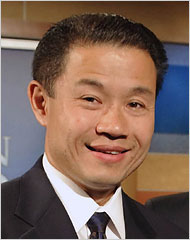November 9, 2009
Written by C.N.
New York Marathon Winner: Not a ‘Real’ American?
A common theme in many of my recent posts has been the backlash among many White Americans against various demographic, cultural, political, economic, and globalized changes taking place in American society and the world in general. As their percentage of the U.S. population continues to shrink, as non-Whites become increasingly prominent in our society (represented at the very top by Barack Obama), and with the recession heightening their fears and insecurities, many White Americans have reacted angrily to their traditional “way of life” being threatened.
As I’ve argued, some recent examples of this kind of subtle and explicit anti-minority and anti-immigrant backlash include incidents of police brutality in San Jose, a newborn taken away from its mother because she was fluent in English, Black and Latino children excluded from an almost all-White swimming club, and various other incidents ranging from harassment to murder.
I don’t really enjoy writing about such incidents and would really like to let it go and instead, focus on more positive aspects of American society moving forward in the 21st century. But unfortunately, these kinds of racist backlash keep happening over and over again. The latest example involves Meb Keflezighi, an Eritrean American who recently won the New York City Marathon. This video clip from MSNBC focuses on his well-earned victory:
Unfortunately, as the New York Times reports, his victory has also led to charges that his victory should not really count as an “American” victory because he is not “really” American:
He was widely celebrated as the first American to win the New York race since 1982. Having immigrated to the United States at age 12, he is an American citizen and a product of American distance running programs at the youth, college and professional levels. But, some said, because he was born in Eritrea, he is not really an American runner. . . .
The online postings about Keflezighi were anonymous. One of the milder ones on Letsrun.com said: “Give us all a break. It’s just another African marathon winner.”
A comment on The New York Times’s site said: “Keflezighi is really another elite African runner by birth, upbringing, and training. Americans are kidding themselves if they say he represents a resurgence of American distance prowess! On the other hand, he is an excellent representative of how we import everything we need!”
In a commentary on CNBC.com, Darren Rovell wrote, “Nothing against Keflezighi, but he’s like a ringer who you hire to work a couple hours at your office so that you can win the executive softball league.”
To clarify, Keflezighi came to the U.S. at the age of 12, so he is part of what sociologists tend to call the “1.5” generation — immigrants who came to the U.S. at age 12 or younger and who were raised, socialized, and educated primarily within American society. As the NY Times article also notes, he is “a product of American distance running programs at the youth, college and professional levels.”
The question becomes, if Keflezighi is not a “real” American, then what exactly are the qualifications of being a “real” American?
Apparently, coming to the U.S. at a young age and being raised and educated in the U.S. doesn’t qualify one as a “real” American. Neither does being a naturalized citizen. And according to many, being born in the U.S. is not enough to qualify someone as a “real” American either, as many Asian Americans will attest to, having their loyalties questioned, challenged, and attacked.
We need to call it for what it is — White racism, plain and simple.
The sad fact is, for many Americans, unless you are White, you will never be a “real” American. That includes non-White or -European immigrants and U.S.-born racial minorities. This institutional mentality has a long tradition throughout American history. Perhaps the best example that comes to mind is the Cherokee Nation.
In the early 1800s, with Whites encroaching on their traditional lands in the south, the Cherokees were basically told that if they wanted to physically survive, they had to discard their “savage” ways and become Americanized. The Cherokees proceeded to do just that and completely changed their way of life — they learned English as well as romanized their traditional language, began wearing “American” clothing, set up a bicameral governing structure based on Congress’s model, and changed their economy from one based on hunting to one focused on farming and trading.
But in the end, their efforts were in vain because they basically learned that despite their actions, since they were not White, they could never be American. The Cherokee were subsequently evicted from their lands and in the infamous “Trail of Tears” episode of American history, forcibly marched from northwestern Georgia and southeastern Tennessee one thousand miles westward. Along the way, about 25% of the estimated 15,000 who started died from starvation, disease, exhaustion, or were murdered before finally reaching the Oklahoma territory and their newly-established “reservations.”
Even though non-Whites may display all the “normal” characteristics and behaviors of a “typical” American — being fluent in English, getting a good education and a good job, owning a nice house in the suburbs, paying taxes, voting in elections, attending Christian churches, going to ballgames and having backyard barbecues — unless you are White, your identity as a “real” American will inevitably be challenged in one way or another.
My fellow Asian American blogger Jenn at Reappropriate argues very succinctly:
Often, naturalized Americans have done more to establish their “American-ness†than those who are American by accident of birth. Which isn’t to say that naturalized Americans are more American than domestically-born Americans; being American isn’t a question of degrees. Instead, it’s simple math: one is or one isn’t American.
As I’ve said before, change does not come easily and without resistance of one kind or another and unfortunately, this anti-immigrant and anti-minority backlash will exist for the foreseeable future.


